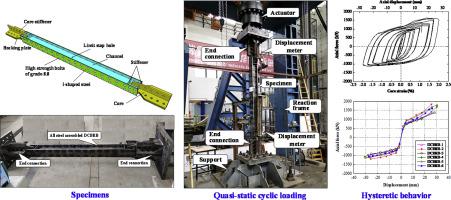Journal of Constructional Steel Research ( IF 4.0 ) Pub Date : 2021-09-17 , DOI: 10.1016/j.jcsr.2021.106925 Fenghua Huang 1 , Haijuan Duan 1, 2 , Bin Cheng 1, 2 , Nianguan Teng 1, 2

|
This paper focuses on the hysteretic behavior of a proposed all-steel assembled double-cores buckling-restrained braces (DCBRB). The DCBRB employs an I-shaped steel and two channels to resist the global instability of the brace and hence to force the double-cores into high-order buckling mode for the purpose of energy dissipation. Six DCBRB specimens were fabricated, where both Q195 low-yield core and Q235B core were concerned for comparison. The quasi-static cyclic loading was conducted on the DCBRB specimens to investigate the failure modes, as well as the hysteretic behavior from different perspectives, such as hysteretic curves, skeleton curves, compressive strength adjustment factor, energy dissipation capacity and plastic deformation performance. The experimental results demonstrate that the insufficient constraining of the external restraining member could cause the global instability of the buckling-restrained braces. The specimens exhibited great and stable hysteretic responses until the axial strains of cores researched 1.5%. Finally, the cumulative plastic deformation capacities were greater than 300 for all specimens. The finite element models were established to further investigate the influence of constraint ratio and core's width-to-thickness ratio on the hysteretic behavior of the DCBRBs. The numerical results reveal that better global stability is expected to be obtained with a larger constraint ratio ζ, and the limit value of ζ avoiding the global buckling almost increases linearly with the increase of core's width-to-thickness ratio.
中文翻译:

使用Q195低屈服芯的全钢装配式双芯抗屈曲支撑的滞回性能
本文重点研究所提出的全钢组装双芯屈曲约束支撑 (DCBRB) 的滞后行为。DCBRB采用工字钢和两个通道来抵抗支撑的整体不稳定性,从而迫使双芯进入高阶屈曲模式以达到能量耗散的目的。制作了 6 个 DCBRB 试样,其中 Q195 低屈服岩心和 Q235B 岩心都用于比较。对DCBRB试件进行准静态循环加载,从滞回曲线、骨架曲线、抗压强度调整因子、耗能能力和塑性变形性能等不同角度研究破坏模式和滞回行为。实验结果表明,外约束构件约束不足会导致屈曲约束支撑的整体不稳定。在岩心轴向应变达到 1.5% 之前,样品表现出很大且稳定的滞后响应。最后,所有试样的累积塑性变形能力均大于 300。建立有限元模型以进一步研究约束比和核心宽厚比对DCBRBs滞后行为的影响。数值结果表明,较大的约束比有望获得更好的全局稳定性 在岩心轴向应变达到 1.5% 之前,样品表现出很大且稳定的滞后响应。最后,所有试样的累积塑性变形能力均大于 300。建立有限元模型以进一步研究约束比和核心宽厚比对DCBRBs滞后行为的影响。数值结果表明,较大的约束比有望获得更好的全局稳定性 在岩心轴向应变达到 1.5% 之前,样品表现出很大且稳定的滞后响应。最后,所有试样的累积塑性变形能力均大于 300。建立有限元模型以进一步研究约束比和核心宽厚比对DCBRBs滞后行为的影响。数值结果表明,较大的约束比有望获得更好的全局稳定性ζ , ζ 避免整体屈曲的极限值几乎随着芯部宽厚比的增加而线性增加。











































 京公网安备 11010802027423号
京公网安备 11010802027423号